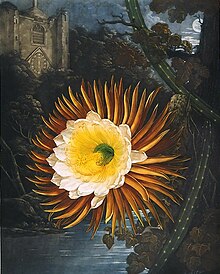|
Abraham Pether
 Abraham Pether (8 October 1752 – 13 April 1812) was an English landscape painter, recognised for his skill in depicting moonlit scenes. He was also a talented musician, inventor, mathematician and philosopher.[1] Life and work Abraham was born on 8th October 1752 in St. James', Piccadilly in London. He was the nephew of the eminent engraver William Pether.[1] In childhood Abraham showed a great talent for music, and at the age of nine played the organ in one of the Chichester churches.[1] Adopting art as his profession, he became a pupil of George Smith,[1][2] whom he greatly surpassed. He painted river and mountain scenery, with classical buildings, in a pleasing though artificial style but his reputation rests on his moonlight subjects, which attracted much admiration, and earned for him the sobriquet of "Moonlight" Pether.[1] He was partial to the combination of moonlight and firelight, as in such subjects as Eruption of Vesuvius, Ship on Fire in a Gale at Night, An Iron foundry by Moonlight etc., which he painted with fine feeling and harmony of colour.[1][2]. In doing so he became one of the finest early English painters of chiaroscuro. [3]  Pether was a major exhibitor with both the Free Society of Artists and the Incorporated Society of Artists from 1773 to 1791, and at the Royal Academy from 1784 to 1811.[1][2] He was a member of the Incorporated Society of Artists.[2] His "Harvest Moon", which was at the Academy in 1795, was highly praised at the time.[1][2] He had an extensive knowledge of scientific subjects, and in his moonlight pictures the astronomical conditions are always correctly observed.[1] Pether was also a clever inventor, constructing telescopes and microscopes for his own use, and lectured on electricity using instruments of his own making.[1][2] He also invented his own type of pencil.[4]  Although his art was popular, Pether was never able to do more than supply the daily wants of his large family, and when attacked by a lingering disease, which incapacitated him for work and eventually caused his death, he was reduced to great poverty.[1] He died at Southampton on 13 April 1812, leaving a widow, Elizabeth, and nine children quite destitute;[1][2] and the fact that they were unable to obtain any assistance from the Artists' Benevolent Fund was made the occasion of a fierce attack upon the management of that society.[1] Elizabeth Pether later went into business with a partner Thomas Thornton as "Pether & Co.", selling black lead and chalk pencils. An advertisement in The Times in 1816 stated of the instruments: "the leads being freed by a chymical process from all impurities, and scratching particles".[4] Abraham Pether and his sons Sebastian (1793–1844) and Henry Pether (1800-1880), specialised in moonlit scenes.[5][6] It is thought that Abraham had a brother called Thomas Pether (they are recorded as sharing a residence); the latter was a wax modeller who exhibited portraits in wax with the Free Society of Artists from 1772 to 1781.[1] See alsoReferences
External linksWikimedia Commons has media related to Abraham Pether.
|
Portal di Ensiklopedia Dunia